Table of Contents
Disabled parking bays are designed to support individuals with mobility impairments by providing convenient and accessible parking spaces.
My neighbour has a disabled parking bay, Can I use it? This question often sparks confusion and debate.
You might see a disabled parking bay outside your neighbour’s house and wonder if it’s legally reserved or if anyone can use it.
Some believe these bays are strictly private, while others assume they’re available for general use. But what does the law actually say?
Misusing a disabled bay can lead to penalties, but the rules vary depending on the type of bay. Understanding the legalities is crucial to avoid fines and ensure fairness.
In this blog, we’ll explore the regulations, potential consequences, and who really has the right to park in these spaces.
What Are Disabled Parking Bays?
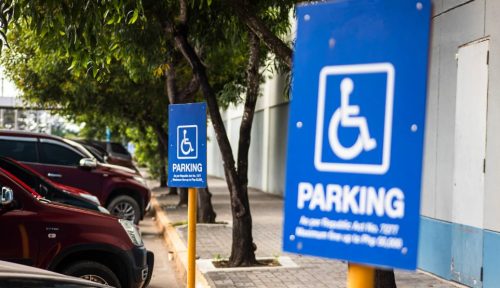
Disabled parking bays are designated spaces for individuals with disabilities who hold a valid Blue Badge.
These bays provide accessible parking close to facilities, homes, and services. Marked by clear signage and road markings, they are easy to identify and essential for mobility.
In the UK, there are two types of disabled parking bays: advisory and mandatory. Advisory bays are not legally enforceable but ask drivers to respect them.
Mandatory bays are legally enforceable, with fines for misuse. Local councils manage these bays to ensure accessibility standards are met.
Disabled parking bays are found in public and private areas. Public bays are regulated by local councils, while private bays, such as those in shopping centres, follow property owners’ rules.
These bays are vital for promoting accessibility and inclusion, ensuring that disabled individuals can travel, park, and access services with ease and dignity.
What Are the Main Purposes of Disabled Parking Bays?
Disabled parking bays are essential for improving mobility and accessibility for individuals with disabilities. Their primary purposes include:
Convenient Access
These bays provide safe, accessible parking near homes, shops, and healthcare facilities, reducing physical strain for those with mobility impairments.
Promoting Independence
Accessible parking helps disabled individuals maintain their daily routines, such as attending medical appointments, going to work, or running errands.
Ensuring Fair Use
By regulating these spaces for Blue Badge holders, councils prevent misuse and ensure that only those who genuinely need them can park there.
Raising Awareness
Clear signage and enforcement deter inconsiderate parking and promote respect for the needs of disabled individuals.
Overall, disabled parking bays are vital for inclusion and accessibility. They not only support independence but also uphold legal protections for those with disabilities
My Neighbour Has a Disabled Parking Bay, Can I Use It?
If your neighbour has a disabled parking bay outside their house, you might wonder whether you can legally park in it.
The answer depends on whether the bay is advisory or mandatory. Advisory bays are not legally enforceable, meaning anyone can technically park in them.
However, doing so can be seen as inconsiderate, as the bay was requested to accommodate a specific individual’s needs.
Mandatory disabled bays, on the other hand, are legally enforceable and require a Blue Badge for use. Parking in such a bay without authorisation can result in fines or penalties.
Local councils enforce these rules to ensure that disabled individuals have the access they need.
While advisory bays are not legally reserved, it’s important to respect their purpose. Even if you are legally allowed to park in your neighbour’s disabled bay, doing so could create tension and make their daily life more difficult.
It is always best to check local council regulations and communicate with your neighbour to avoid disputes.
What Are the Consequences of Parking in a Disabled Bay Without Permission?
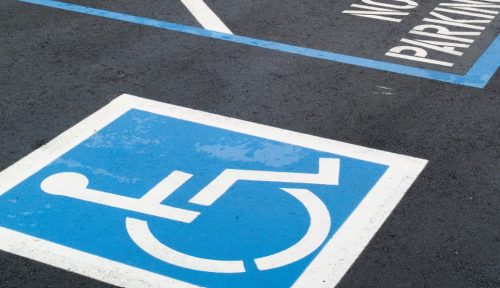
Parking in a disabled bay without authorisation can have several consequences, depending on whether the bay is advisory or mandatory.
Legal Consequences
- If the bay is mandatory, you could receive a Penalty Charge Notice (PCN).
- Fines typically range from £70 to £130, depending on the council and location.
- Repeat offenders may face court action or higher penalties.
Social and Ethical Consequences
- Taking a disabled bay may prevent a disabled person from accessing essential services.
- Parking in an advisory bay could create conflicts with neighbours.
- It may lead to complaints to the council or disputes in the community.
Reporting and Enforcement
- Local councils and parking wardens monitor mandatory disabled bays.
- Members of the public can report misuse of a disabled bay to local authorities.
- Some private parking areas use CCTV enforcement to issue fines automatically.
If you are unsure whether a bay is mandatory or advisory, it’s best to avoid parking in it to prevent legal and ethical issues.
Are Residential Disabled Parking Bays Reserved for Specific Individuals?
Many people believe that disabled parking bays outside a home are reserved for a particular person. However, in most cases, this is not true.
Residential disabled parking bays, whether advisory or mandatory, are intended for any Blue Badge holder, not just the individual who requested the bay.
Even if your neighbour applied for the bay, they do not legally own it. If another Blue Badge holder needs to use the space, they are generally allowed to do so.
This means that while the bay benefits a specific resident, it remains a publicly available resource for any qualifying user.
However, some cases involve personalised disabled bays, which are assigned to an individual. These are rare and usually granted only in exceptional circumstances.
If you are uncertain about a particular bay, checking with the local council can clarify its usage restrictions.
How to Identify If a Disabled Parking Bay Is Advisory or Mandatory?
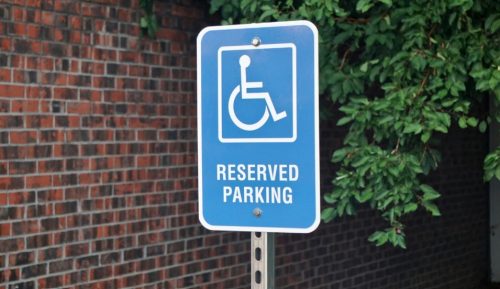
Knowing whether a disabled parking bay is advisory or mandatory is essential to avoid penalties. Here’s how to identify them:
Advisory Bays
- Marked with white painted lines around the bay.
- No Blue Badge is required for parking here.
- Not legally enforceable, use is voluntary and discretionary.
- Installed as a courtesy measure for disabled individuals’ convenience.
Mandatory Bays
- Marked with yellow lines and clear, visible signage.
- Legally enforceable, parking without a Blue Badge can result in fines.
- Often have a wheelchair symbol painted on the ground for clear identification.
- Monitored by councils or parking enforcement officers regularly.
If you are unsure, look for signage showing enforcement rules or contact your local council for further confirmation.
Understanding these differences helps you park responsibly and avoid fines.
What to Do If Your Neighbour Wrongfully Uses a Disabled Parking Bay?
If your neighbour or another person wrongfully uses a disabled parking bay, it can create inconvenience for those who genuinely need it.
The right course of action depends on whether the bay is advisory or mandatory.
Steps to Address the Issue
- Verify if the bay is advisory or mandatory: Advisory bays are not legally enforceable, while mandatory bays require a Blue Badge.
- Talk to your neighbour: They may not be aware of the rules or how the bay is intended to be used.
- Check council regulations: Local councils have different policies regarding enforcement, so it’s best to confirm the rules for your area.
- Report to the authorities: If the bay is mandatory and someone is misusing it, you can report the issue to your local council or parking enforcement officers.
- Document the misuse: If someone repeatedly parks in a disabled bay without authorisation, take photos and note the dates and times to support your complaint.
When Can the Council Take Action?
- If the disabled bay is mandatory, the council can issue a Penalty Charge Notice (PCN).
- If the disabled bay is advisory, enforcement is limited, but you may still raise concerns with the council.
- Private disabled bays in supermarkets or residential complexes may have separate enforcement policies, often managed by private parking companies.
If speaking with your neighbour does not resolve the issue, formal complaints can be submitted to the council or local authorities to address the situation.
Can a Disabled Parking Bay Be Removed or Relocated?
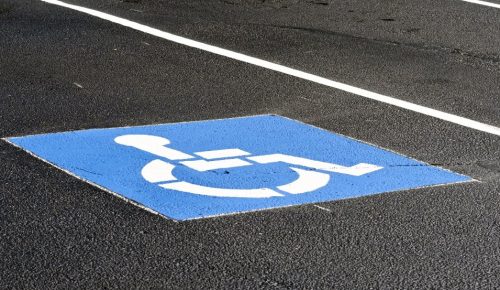
There are certain situations where a disabled parking bay may need to be removed or relocated.
This typically happens if the person who initially applied for the bay no longer requires it or if there are changes to road layouts.
Reasons for Removing or Relocating a Disabled Bay
- The original applicant no longer resides at the property.
- The disabled resident has passed away or no longer drives.
- The bay is no longer used frequently and is causing parking disputes.
- Roadworks or changes to traffic flow require the bay to be relocated.
How to Request a Removal or Relocation
- Contact the local council: They will review whether the bay is still necessary.
- Provide necessary documentation: The council may ask for proof that the bay is no longer needed.
- Wait for an assessment: The council will send an inspector to review the bay’s necessity.
- Decision is made: If approved, the bay markings will be removed or repainted elsewhere.
The process can take several weeks or months, depending on the council’s policies and workload.
How to Apply for a Disabled Parking Bay Outside Your House?
If you or a family member require a disabled parking bay outside your house, you can apply through your local council. Not everyone qualifies, and there are specific criteria to meet.
Eligibility Criteria
- The applicant must be a Blue Badge holder.
- The vehicle must be registered at the applicant’s address.
- The applicant must have difficulty parking near their home due to limited street parking.
- The road must be publicly maintained (private roads do not qualify for council-installed bays).
Application Process
- Check eligibility: Review your local council’s website for requirements.
- Submit an application: This can usually be done online or via a form.
- Provide documentation: Councils may require proof of the applicant’s disability, vehicle registration, and Blue Badge.
- Council inspection: An officer may visit to assess whether a bay is necessary.
- Approval and installation: If approved, the council will mark the bay outside your home.
How Long Does It Take?
The approval and installation process can take 6-12 weeks, depending on council workloads. Some councils may charge an administration fee for the application.
What Are the Rules for Disabled Parking Bays in Private Areas?
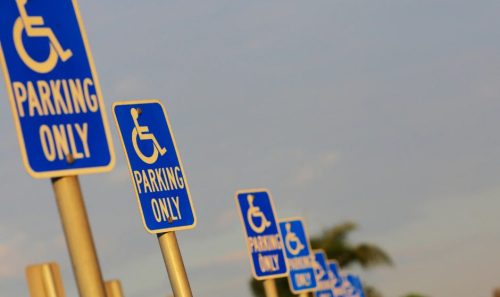
Disabled parking bays are not limited to public roads, many private car parks also have designated spaces for disabled drivers.
However, the rules for using these bays differ depending on who owns the property. Here are the key differences between public and private disabled bays:
Public disabled bays (e.g., on residential streets, town centres)
- Managed by local councils.
- Mandatory bays are legally enforceable.
- Blue Badge holders can park for free in most areas.
Private disabled bays (e.g., supermarkets, shopping centres, apartment complexes)
- Managed by the property owner or private parking company.
- Enforcement varies – some sites issue fines for misuse.
- Private landowners set their own rules, which may differ from council regulations.
It’s important to check the specific rules for private disabled parking bays, as enforcement and regulations can vary.
Always follow the guidelines set by property owners to avoid fines or penalties
Can Private Car Parks Issue Fines?
Yes, many private car parks employ parking enforcement officers or use CCTV to issue fines to vehicles parked illegally in disabled bays.
These fines are not issued by councils but by private parking companies.
How to Challenge an Unfair Fine?
- Contact the parking company and request evidence of the violation.
- If the fine seems unfair, appeal through the British Parking Association (BPA) or the Parking on Private Land Appeals (POPLA) service.
- If the case is escalated, seek legal advice before paying the fine.
Always check signs in private car parks to ensure you are following the specific rules in that area.
Conclusion
Understanding disabled parking bay rules is crucial to ensure these spaces remain accessible to those who need them most.
While advisory bays aren’t legally enforceable, mandatory bays require a Blue Badge, and misuse can result in fines.
If you’re unsure about using a disabled bay outside your neighbour’s house, check your local council’s guidelines.
Parking in a mandatory bay without permission can lead to penalties and disputes. For fair access, apply through your local council for a disabled parking bay.
Reporting misuse helps maintain accessibility for those who genuinely need it. By respecting these rules, we promote a more inclusive and accessible community.
FAQs
Do you need a Blue Badge to use a disabled parking bay outside a house?
Yes, mandatory disabled bays require a Blue Badge, but advisory bays do not legally enforce restrictions. However, using any disabled bay without need is discouraged.
What is the difference between a disabled bay and a general parking bay?
A disabled bay is specifically reserved for Blue Badge holders and is marked with special road signs, while a general parking bay is available for all drivers.
Can you report someone for parking in a disabled bay without permission?
Yes, if the bay is mandatory, you can report misuse to your local council or parking enforcement officers for possible fines.
What are the penalties for misusing a disabled parking space?
Fines for parking in a mandatory disabled bay without a Blue Badge range from £70 to £130, depending on the council and location.
Are disabled parking bays monitored by local councils?
Yes, councils and traffic wardens regularly check mandatory disabled bays, and some areas use CCTV for enforcement.
Can a disabled bay be used by visitors of the Blue Badge holder?
Yes, but only if the Blue Badge holder is in the vehicle or being picked up/dropped off; otherwise, it may be considered misuse.
Can a homeowner request a disabled bay removal if it’s no longer needed?
Yes, a request can be made to the local council, which will assess whether the bay should be removed or kept for other disabled residents.




